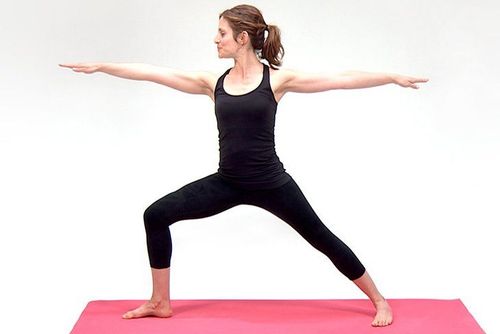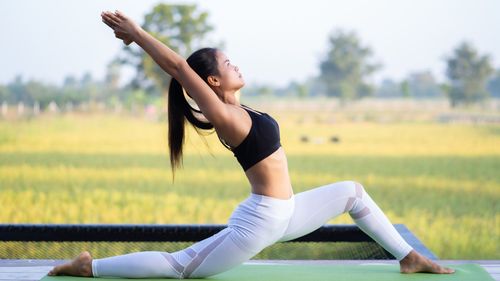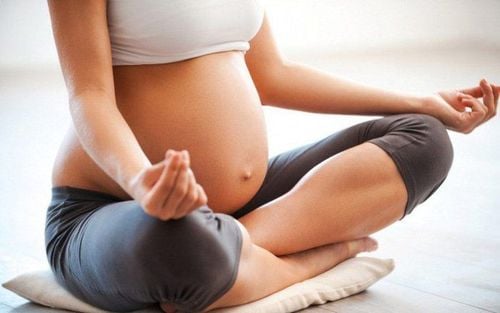This is an automatically translated article.
Yoga is a body practice that unites body and mind. It combines breathing exercises, meditation and postures to help the practitioner relax and reduce stress. The effect of yoga is recognized after a few weeks of hard practice.
1. Benefits of practicing yoga
Practicing yoga has many benefits for mental and physical health. Specifically:
1.1 Stress relief
Yoga is known for its ability to relieve stress and promote relaxation. In fact, many studies have shown that practicing yoga can reduce the production of cortisol - a major stress hormone. Therefore, when practicing yoga alone or in combination with other stress-reduction methods such as meditation, yoga helps manage stress effectively.
SEE ALSO: Yoga meditation – A therapy to help cope with stress
1.2 Reduce anxiety
There are many studies that show that yoga helps reduce anxiety, thereby helping people deal with feelings of anxiety. The peaceful feeling that yoga brings to the practitioner helps treat anxiety.

Tập yoga cải thiện tình trạng lo âu, căng thẳng
1.3 Reduce inflammation
In addition to improving mental health, some studies show that practicing yoga can help reduce inflammation. Inflammation is a normal immune response of the body. But chronic inflammation can contribute to the development of pro-inflammatory conditions like cardiovascular disease, diabetes, and cancer. Many studies have shown that practicing yoga can help protect against certain diseases caused by chronic inflammation.
1.4 Improve heart health
Having the function of pumping blood throughout the body to deliver important nutrients to tissues, heart health is an essential component of overall health. And many studies show that yoga can improve heart health and reduce some risk factors for heart disease (high blood pressure, heart palpitations). At the same time, some studies also show that combining yoga with a healthy lifestyle also helps slow the progression of heart disease. Since yoga helps reduce stress - one of the main causes of heart disease - yoga helps protect the heart better.
1.5 Improve quality of life
Yoga is becoming more and more popular as a supportive therapy to improve people's quality of life. Studies show that yoga improves mood, reduces fatigue in healthy people. At the same time, yoga also improves sleep quality, lifts spirits, and reduces symptoms of anxiety and depression in cancer patients.
1.6 Fight against depression
Some studies show that practicing yoga can work against depression and help reduce symptoms of depression. This is because yoga can lower levels of cortisol - a stress hormone that affects levels of serotonin - a neurotransmitter linked to depression. Since then, yoga is effective in treating depression when used alone or when combined with traditional treatment methods.

Bệnh nhân trầm cảm được khuyên nên tập yoag thường xuyên
1.7 Chronic pain relief
Chronic pain is a persistent problem that affects millions of people and has many causes, be it injury or arthritis. There are many studies that show that practicing yoga can help reduce many chronic pain benefits. Therefore, people with chronic pain should practice yoga daily to effectively relieve pain.
1.8 Promotes sleep quality
Poor sleep quality is linked to obesity, high blood pressure, depression and several other disorders. Studies show that practicing yoga daily can help you fall asleep faster, fall asleep faster, and feel more comfortable when you wake up. This is because yoga increases the secretion of melatonin - a hormone that regulates sleep and alertness. At the same time, yoga also helps reduce anxiety, depression, chronic pain and stress - common causes of sleep problems. Therefore, you can refer and try to practice Yoga before going to bed.
1.9 Improved flexibility and balance
Many people have included yoga in their practice routine to improve flexibility and balance of the body. Yoga uses specific postures to make the body more flexible and balanced. Therefore, if you want to increase the flexibility of the body, each person should practice 15 - 30 minutes of yoga every day.
1.10 Improve breathing
Pranayama - the practice of breath control in yoga is a yoga practice that focuses on controlling the breath through breathing techniques. Most types of yoga incorporate this breathing exercise and it helps to improve breathing.
In fact, air capacity is a measure of the maximum amount of air that can be taken out of the lungs. It is especially important for patients with lung disease, heart disease and asthma. Practicing breath control in yoga improves breathing, builds endurance, optimizes performance, and keeps your heart and lungs healthy.

Các bài tập yoga giúp kiểm soát hơi thở và hữu ích đối với bệnh nhân hen suyễn
1.11 Migraine relief
Migraine is a common condition, encountered in many different groups of people. Typically, migraine sufferers are treated with medication to relieve pain and control symptoms. However, more and more research is demonstrating that yoga is an adjunct therapy to reduce migraine frequency and intensity compared with conventional care alone. Researchers suggest that practicing yoga helps stimulate the vagus nerve, which helps relieve migraines.
MORE: Does yoga reduce headaches, is it effective?
1.12 Promote healthy eating habits
Yoga practitioners pay attention to the taste, smell, texture of food and the sensation experienced when eating. Practicing yoga helps promote healthy eating habits, control blood sugar levels, increase weight loss according to needs, and treat disordered eating behaviors. Since yoga focuses on training the mind, it can be used to encourage healthy eating behaviors.
1.13 Strength enhancement
In addition to improving flexibility, practicing yoga also has strength-building benefits for the body. In fact, there are specific poses in yoga that strengthen and strengthen muscles. As such, practicing yoga is also an effective way to increase body strength and endurance, especially when combined with a regular exercise routine.
2. How long does it take to practice yoga to be effective?
Yoga is a method of body-mind training that can help practitioners have good health and a beautiful body. However, the time it takes for the benefits of yoga to begin to manifest will depend on your personal goals, when to start, the details of your yoga practice, etc. Usually, the effects of yoga appear later. few weeks of hard training. But depending on your goals, it can take a few more weeks to see lasting benefits.
The effectiveness of yoga according to different goals is as follows:

Để tập yoga hiệu quả yêu cầu người tập có sự kiên nhẫn và bền bỉ
2.1 With the goal of improving health
The US Department of Health and Human Services recommends that each person strengthen all major muscle groups twice a week for optimal health. Yoga poses that help strengthen muscles are the right choice of practice. Within the first few weeks after practicing, the practitioner will see the effects of yoga exercises. After about 16 training sessions, equivalent to 8 weeks of training, muscle size, strength or endurance will have an increase.
If you choose more restorative, gentle forms of yoga, you need to combine it with other exercises to build strength. Strength training offers many benefits such as stronger muscles, stronger bones, reduced symptoms of many chronic diseases, improved quality of life, improved cognitive ability, and more.
2.2 With the goal of protecting the heart
Practicing yoga to get in shape also shares the same goal with building cardiovascular health. According to the recommendations of the US Department of Health and Human Services, each person should do a minimum of 150 minutes of moderate physical activity or 75 minutes of vigorous activity each week. Active forms of yoga like Vinyasa yoga (which combines strength and lightness) can count toward moderate-intensity activity.
After 2 weeks, the exerciser has better self-regulation of the heart. Most of the effects of yoga on heart health are more apparent after 12 weeks (3 months) or more. However, if you practice yoga diligently, you will find that the practice becomes easier, with more visible effects after only a few weeks.
Just like strength training, if you like more restorative, gentle forms of yoga, you should combine it with other forms of exercise for good health. The forms can be walking, cycling, swimming, dancing,...
MORE: Can you lose weight while practicing Yoga?

Một trong những lợi ích của tập yoga là bảo vệ sức mạnh tim mạch
2.3 With the goal of losing weight
Because there are many types of yoga with different intensities, it is difficult to estimate the number of calories the body burns after practicing yoga. For example, with Hatha yoga - a relatively gentle exercise, it can burn 240 - 356 calories / hour depending on the body weight of the practitioner. That's the same calorie-burning rate as walking at 5.6km/h.
The balance between calories burned and calories taken in will determine the chances of successful weight loss. And practicing yoga helps encourage some healthy behaviors for weight loss. Specifically, yoga practitioners often eat more vegetables and fruits, are more physically active, and consume less fast food and sugary drinks. Since then, the weight loss effect is improved.
How long does yoga practice to lose weight? If you lose weight at a rate of 450 - 900g/week, you can keep this steady weight loss for a long time.
Practicing yoga has many physical and mental benefits. Incorporating yoga into your daily routine will help promote health, increase strength, flexibility and reduce symptoms of stress, anxiety, and depression.
Please dial HOTLINE for more information or register for an appointment HERE. Download MyVinmec app to make appointments faster and to manage your bookings easily.
References: livestrong.com, healthline.com













